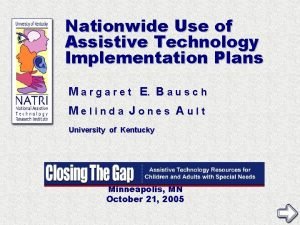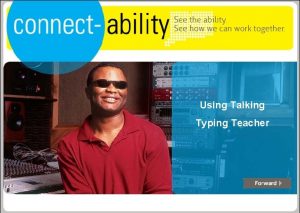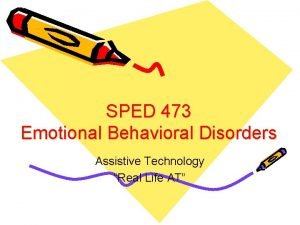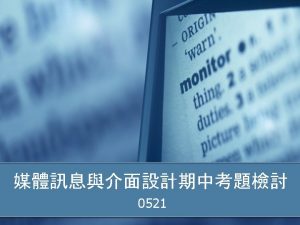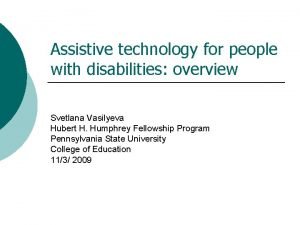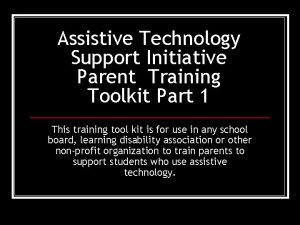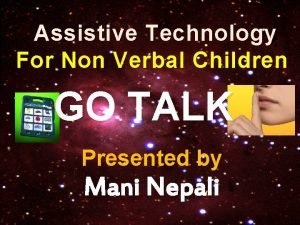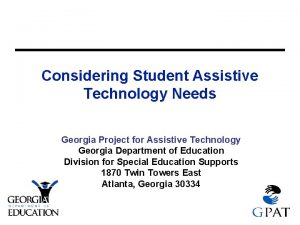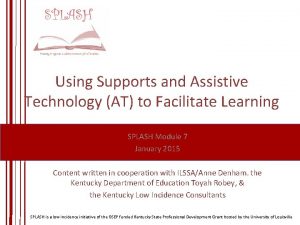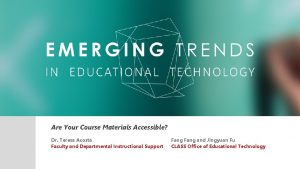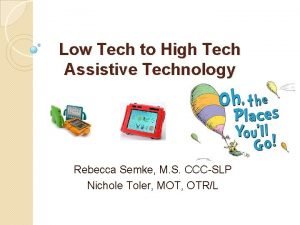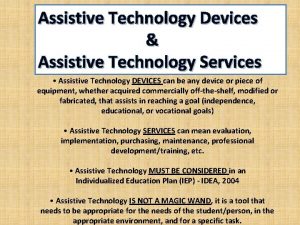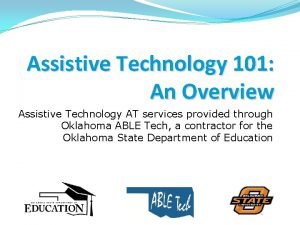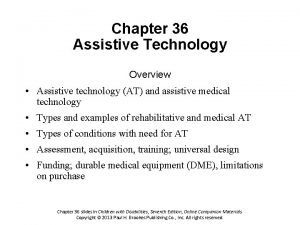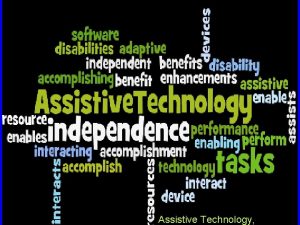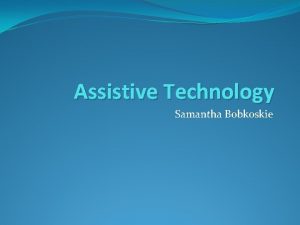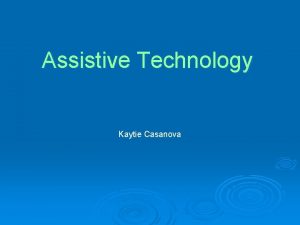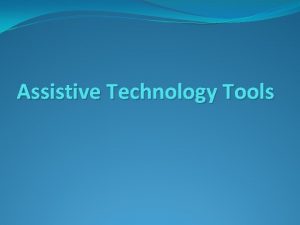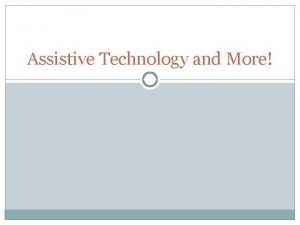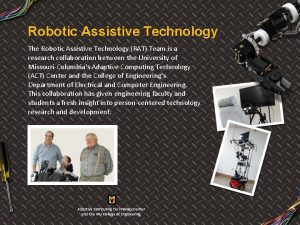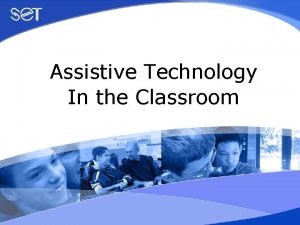Assistive Technology in the NC State Technology Plan














- Slides: 14

Assistive Technology in the NC State Technology Plan In compliance with federal law, including the provisions of Title IX of the Education Amendments of 1972, the North Carolina Department of Public Instruction does not discriminate on the basis of race, sex, religion, color , national or ethnic origin, age, disability, or military service in its policies, programs activities, admissions or employment.

No Child Left Behind Act of 2001 • disaggregate student assessment data, provide greater access to learning • provide resources for students with special needs. • To assist every student in crossing the digital divide by ensuring that every student is technologically literate by the time the student finishes the eighth grade, regardless of the student's race, ethnicity, gender, family income, geographic location, or disability. (NCLB) Assistive technology provides support to enable students with disabilities participate in instruction while creating responses and products that equal or closely resemble those of their peers.

IDEA § IDEA to ensure that educators and parents have the necessary tools to improve educational results for children with disabilities by supporting systemic-change activities; coordinated research and personnel preparation; coordinated technical assistance, dissemination, and support; and technology development and media services; and § IDEA Part D Chapter 1 section 672 Advancing the design, development, and integration of technology, assistive technology devices, media, and materials, to improve early intervention, educational, and transitional services and results for children with disabilities. § http: //www. ideapractices. org/law/regulations/index. php

Improve teaching and learning through the appropriate use of technology North Carolina proposed in its plan to include students with the most significant cognitive disabilities in its accountability system based on their performance on an alternate assessment that would hold those students to different achievement standards from those all other students are expected to meet. All students with disabilities must be included in a State’s accountability system. http: //www. ed. gov/admins/lead/account/letters/nc. doc

Legislation – Accessible Technology § North Carolina General Statute Section 168 A-7, Discrimination in Public Service (http: //www. ncleg. net/Enacted. Legislation/Statutes/HTM L/By. Section/Chapter_168 A/GS_168 A-7. html) requires the provision of “reasonable aids and adaptations necessary for a known qualified person with a disability to use or benefit from existing public services operated by such entity; provided that the aids and adaptations do not impose an undue hardship on the entity involved. ” Public services include “but (are) not limited to education, health, social services, recreation, and rehabilitation. ”

Technology Plan § Strategic goal 3 in the state ed tech plan (http: //tps. dpi. state. nc. us/Tech. Plan 0509/TECHP L%7 E 3. DOC. pdf) states that NCPDI will “Provide guidance in the creation and maintenance of accessible, user friendly, and informative Web sites” (p. 14)

Appropriate technology-based instructional strategies are used for students with unique needs. Direct Benefit to Teaching and Learning • Student achievement is improved when assistive technology for special needs students and technology based instructional alternatives for at-risk students are available Reality • Assistive devices for special needs students are not readily available in all school divisions. • School divisions lack technology resources for meeting the needs of at-risk students. • Technology-based strategies for providing general remediation are not currently available in all school divisions. Gap • Assistive technology for special needs students and technology-based resources for at-risk students and for remediation need to be available in all school divisions to aid student learning.

Progress Measures • The percentage of schools reporting that special needs students have access to assistive technologies when needed • The percentage of schools reporting that at-risk students have access to technology-based instructional alternatives when needed • The percentage of schools reporting that access to technologybased solutions for general remediation is available when needed

State Level • Identify site-based technology application models and strategies for students with unique needs. • Identify organizations that provide access to adaptive technologies for special needs students. • Provide professional development opportunities in the area of assistive technology

School Divisions Provide adaptive and instructional technology for special needs populations. • Include funding for assistive technology in the budget for special education departments. • Identify and provide specialized instructional resources for at-risk students and for remediation needs. • Identify and analyze assistive technology resources that accommodate individual student learning needs. • Apply assistive technology to the instructional process and evaluate its impact on learners with diverse backgrounds, characteristics and abilities. All school districts shall establish a process and written guidelines to provide consistency in serving various learning styles through adaptive/assistive technology services and devices, in accordance with the Individuals with Disabilities Education Act of 1997 (IDEA).

Stakeholders § Vendors provide information on free or low-cost access to assistive technology. § Professional organizations identify grants that support assistive technology programs. § Community organizations establish a grant in support of assistive technology programs.

Data Collection Methods and Evidence Resources • IEPs • Student evaluations/screening for Special Education services • Job description • Faculty professional development training • Online workshops • College of Education technology plans • IEP/Progress reports • Student evaluations for Special Education services • Professional development feedback and evaluation forms

Free Resources § http: //www. cfv. org/ Media Caption § http: //bobby. watchfire. com free review of website to see if it is disability user friendly § Accessibility Options in Windows Control Panel § Free Downloads of Assistive Technology for evaluation purposes http: //www. synapseadaptive. com/demosite. htm § Assistive Technology Website http: //tps. dpi. state. nc. us/ncaect 05/presentations/Melanie/assistivetech/index. htm

Works Cited Anderson, L. (1996). Guidebook for developing an effective instructional technology plan, Version 2. 0. Mississippi State, MS: Mississippi State University. Gregg, S. (1995). ADHD—Building academic success. Policy Briefs. Charleston, WV: AEL. No Child Left Behind. 8 January 2002. U. S. Department of Education. http: //www. ed. gov/nclb/landing. jhtml? src=ln The Individuals with Disabilities Education Act of 1997 (IDEA). 4 June 1997. United State of America. http: //www. ideapractices. org/law/index. php
 Assistive technology implementation plan
Assistive technology implementation plan Talking typing
Talking typing Assistive technology for emotional and behavioral disorders
Assistive technology for emotional and behavioral disorders Assistive technology wikipedia
Assistive technology wikipedia Meaning of assistive technology
Meaning of assistive technology Assistive technology for english language learners
Assistive technology for english language learners Illinois assistive technology
Illinois assistive technology Don johnson assistive technology
Don johnson assistive technology Go talk assistive technology
Go talk assistive technology Georgia project for assistive technology
Georgia project for assistive technology Assistive technology toys
Assistive technology toys Noita eye puzzle
Noita eye puzzle Reading untagged document with assistive technology
Reading untagged document with assistive technology Low tech assistive technology for communication
Low tech assistive technology for communication Assistive devices for carpal tunnel syndrome
Assistive devices for carpal tunnel syndrome
